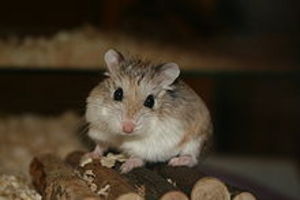How long do dwarf hamsters live? It depends on which one of four pet dwarf hamster species they are, how well they are cared for and if they come down with diabetes. There are four species of dwarf hamsters kept as pets ‘” the Chinese, the Russian, the winter white and the Roborovski.
Russian Dwarf (Phodopus cambelli)
Also known as the Djungarian and the Campbell’s dwarf hamster, this is the most popular dwarf hamster species kept as pets. Adults weigh a whopping once ounce and, with luck, can live up to 2 years, according to Sharon Vanderlip, DVM. Because they are so small, they need to be treated gently to avoid internal damage.
They also need cages specifically for dwarf hamsters and not the larger and more familiar Syrian hamster, or they will escape. How long do dwarf hamsters live? Not long when they have escaped from the safety of their cages and can be stepped on, sat on or chew an electric wire.
Female Russian dwarfs experience a very brief pregnancy which lasts an average of 18 to 22 days. Pups nurse for three weeks and then they are weaned. Males must be separated from females or they will breed as early as one month old.
Unfortunately, Russian dwarf hamsters are prone to developing diabetes, which may shorten their life span. There is no insulin shots for hamsters to bring them out of a diabetic coma, so diabetic hamsters need their blood sugar controlled through diet. Small Animal Angel Rescue reports that some diabetic dwarf hamsters have lived normal life spans.
Winter White (Phodopus sungorus)
Also called the Siberian hamster and striped hairy-footed hamster, they also average 18 months to 2 years old. They are slightly larger than the Russian dwarf and can weigh up to 2 ounces. Gestation can last up to 25 days, but they are weaned by day 20. They rarely get diabetes.
Stress can shorten their lifespans. Because they so resemble a Russian dwarf hamster, many are forced to live with Russian dwarfs and even breed with them. Any offspring is sterile. But winter whites are far more relaxed living with their own species. A hamster that is not stressed is better able to defend against illness.
Chinese (Cricetus griseus)
The Chinese dwarf hamster, also known as the rat-like hamster, is the largest of the four dwarf hamster species, growing up to 5 inches long and weighing up to 1.5 ounces. They are much slimmer than all of the other species and slimmer than even a Syrian hamster. The female’s gestation averages 21 days and the pups are weaned by day 21. They can live up to three years.
Chinese dwarf hamsters get along great with people but hate other hamsters. Breeding is strenuous and often much fighting ensues. If you have a Chinese hamster, it is best not to breed it in order to give it as long a life as possible. They also should be cared for and handled by adults because they are more skittish than a Syrian or Russian dwarf hamster. Children may drop them and give them internal injuries.
Roborovski (Phodopus roborovskii)
Also known as Robos, this is the smallest of the dwarf hamster species that grow only to the size of a ping-pong ball. They weigh from one half to three-quarters of an ounce. They are far too small to handle. They need to be kept in aquariums as they are small enough to escape wire-bar cages made for Syrian or even Russian dwarf hamsters. Sharon Vanderlip, DVM describes them as “escape artists.”
They can live in small colonies with one male to no more than four females. Two males will fight to the death. If the small colony is fighting or if the cage stinks the day after cleaning, the cage is too small. Roborovskis that are too crowded are prone to stress and getting illnesses, especially respiratory illnesses from urine fumes. With luck, they can live to be three and a half years old.
Conclusion
Dwarf hamsters live anywhere from 18 months to three and half years, depending on their species, how stressed they are, if they sustain injury, if they escape or if they develop diabetes. Although small, they require a large commitment of money, time and quality housing in order to have their best chances of living to their maximum life span.
References
Vanderlip, DVM, Sharon. “Name That Hamster.” Critters 2007 Annual. Bow Tie Press; 2006.
Hamsterific.com. “Species Table.” http://www.hamsterific.com/speciestable.cfm
Small Animal Angel Rescue. “Caring for Diabetic Dwarf Hamsters.” http://www.smallangelsrescue.org/doc/small_angels_rescue_dwarf_diabetes_info.pdf









